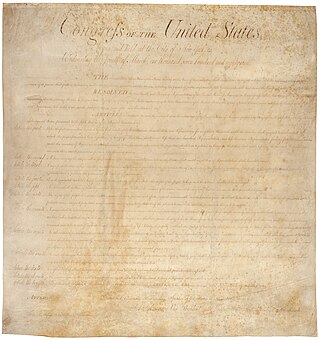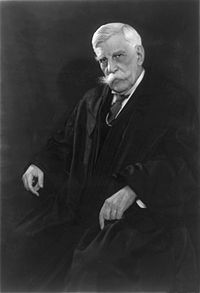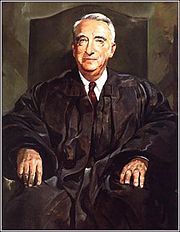Schenck v. United States, 249 U.S. 47 (1919), was a landmark decision of the U.S. Supreme Court concerning enforcement of the Espionage Act of 1917 during World War I. A unanimous Supreme Court, in an opinion by Justice Oliver Wendell Holmes Jr., concluded that Charles Schenck, who distributed flyers to draft-age men urging resistance to induction, could be convicted of an attempt to obstruct the draft, a criminal offense. The First Amendment did not protect Schenck from prosecution, even though, "in many places and in ordinary times, Schenck, in saying all that was said in the circular, would have been within his constitutional rights. But the character of every act depends upon the circumstances in which it is done." In this case, Holmes said, "the words used are used in such circumstances and are of such a nature as to create a clear and present danger that they will bring about the substantive evils that Congress has a right to prevent." Therefore, Schenck could be punished.
Dennis v. United States, 341 U.S. 494 (1951), was a United States Supreme Court case relating to Eugene Dennis, General Secretary of the Communist Party USA. The Court ruled that Dennis did not have the right under the First Amendment to the United States Constitution to exercise free speech, publication and assembly, if the exercise involved the creation of a plot to overthrow the government. In 1969, Dennis was de facto overruled by Brandenburg v. Ohio.
Brandenburg v. Ohio, 395 U.S. 444 (1969), is a landmark decision of the United States Supreme Court interpreting the First Amendment to the U.S. Constitution. The Court held that the government cannot punish inflammatory speech unless that speech is "directed to inciting or producing imminent lawless action and is likely to incite or produce such action". Specifically, the Court struck down Ohio's criminal syndicalism statute, because that statute broadly prohibited the mere advocacy of violence. In the process, Whitney v. California (1927) was explicitly overruled, and Schenck v. United States (1919), Abrams v. United States (1919), Gitlow v. New York (1925), and Dennis v. United States (1951) were overturned.
Whitney v. California, 274 U.S. 357 (1927), was a United States Supreme Court decision upholding the conviction of an individual who had engaged in speech that raised a threat to society. Whitney was explicitly overruled by Brandenburg v. Ohio in 1969.
Gitlow v. New York, 268 U.S. 652 (1925), was a landmark decision of the United States Supreme Court holding that the Fourteenth Amendment to the United States Constitution had extended the First Amendment's provisions protecting freedom of speech and freedom of the press to apply to the governments of U.S. states. Along with Chicago, Burlington & Quincy Railroad Co. v. City of Chicago (1897), it was one of the first major cases involving the incorporation of the Bill of Rights. It was also one of a series of Supreme Court cases that defined the scope of the First Amendment's protection of free speech and established the standard to which a state or the federal government would be held when it criminalized speech or writing.
Abrams v. United States, 250 U.S. 616 (1919), was a decision by the Supreme Court of the United States upholding the 1918 Amendment to the Espionage Act of 1917 which made it a criminal offense to urge the curtailment of production of the materials necessary to wage the war against Germany with intent to hinder the progress of the war. The 1918 Amendment is commonly referred to as if it were a separate Act, the Sedition Act of 1918.
"Imminent lawless action" is one of several legal standards American courts use to determine whether certain speech is protected under the First Amendment of the United States Constitution. The standard was first established in 1969 in the United States Supreme Court case Brandenburg v. Ohio.
"Shouting fire in a crowded theater" is a popular analogy for speech or actions whose principal purpose is to create panic, and in particular for speech or actions which may for that reason be thought to be outside the scope of free speech protections. The phrase is a paraphrasing of a dictum, or non-binding statement, from Justice Oliver Wendell Holmes Jr.'s opinion in the United States Supreme Court case Schenck v. United States in 1919, which held that the defendant's speech in opposition to the draft during World War I was not protected free speech under the First Amendment of the United States Constitution. The case was later partially overturned by Brandenburg v. Ohio in 1969, which limited the scope of banned speech to that which would be directed to and likely to incite imminent lawless action.

Masses Publishing Co. v. Patten, 244 F. 535, was a decision by the United States District Court for the Southern District of New York, that addressed advocacy of illegal activity under the First Amendment. The Second Circuit Court of Appeals overturned Hand’s ruling in Masses Publishing Co. v. Patten (1917).

Zechariah Chafee Jr. was an American judicial philosopher and civil rights advocate, described as "possibly the most important First Amendment scholar of the first half of the twentieth century" by Richard Primus. Chafee's avid defense of freedom of speech led to Senator Joseph McCarthy calling him "dangerous" to America.
In United States law, the bad tendency principle was a test that permitted restriction of freedom of speech by government if it is believed that a form of speech has a sole tendency to incite or cause illegal activity. The principle, formulated in Patterson v. Colorado (1907), was seemingly overturned with the "clear and present danger" principle used in the landmark case Schenck v. United States (1919), as stated by Justice Oliver Wendell Holmes Jr. Yet eight months later, at the start of the next term in Abrams v. United States (1919), the Court again used the bad tendency test to uphold the conviction of a Russian immigrant who published and distributed leaflets calling for a general strike and otherwise advocated revolutionary, anarchist, and socialist views. Holmes dissented in Abrams, explaining how the clear and present danger test should be employed to overturn Abrams' conviction. The re-emergence of the bad tendency test resulted in a string of cases after Abrams employing that test, including Whitney v. California (1927), where a woman was convicted simply because of her association with the Communist Party. The court ruled unanimously that although she had not committed any crimes, her relationship with the Communists represented a "bad tendency" and thus was unprotected. The "bad tendency" test was finally overturned in Brandenburg v. Ohio (1969) and was replaced by the "imminent lawless action" test.
Terminiello v. City of Chicago, 337 U.S. 1 (1949), was a case in which the Supreme Court of the United States held that a "breach of peace" ordinance of the City of Chicago that banned speech that "stirs the public to anger, invites dispute, brings about a condition of unrest, or creates a disturbance" was unconstitutional under the First and Fourteenth Amendments to the United States Constitution.
Kunz v. New York, 340 U.S. 290 (1951), was a United States Supreme Court case finding a requirement mandating a permit to speak on religious issues in public was unconstitutional. It was argued October 17, 1950, and decided January 15, 1951, 8–1. Chief Justice Vinson delivered the opinion for the Court. Justice Black and Justice Frankfurter concurred in the result only. Justice Jackson dissented.

In the United States, some categories of speech are not protected by the First Amendment. According to the Supreme Court of the United States, the U.S. Constitution protects free speech while allowing limitations on certain categories of speech.

The Smith Act trials of Communist Party leaders took place in New York City from 1949 to 1958. These trials were a series of prosecutions carried out by the US federal government during the postwar period and the Cold War era, which was characterized by tensions between the United States and the Soviet Union. The leaders of the Communist Party of the United States (CPUSA) faced accusations of violating the Smith Act, a statute that made it illegal to advocate for the violent overthrow of the government. In their defense, the defendants claimed that they advocated for a peaceful transition to socialism and that their membership in a political party was protected by the First Amendment's guarantees of freedom of speech and association. The issues raised in these trials were eventually addressed by the US Supreme Court in its rulings Dennis v. United States (1951) and Yates v. United States (1957).
Sacher v. United States, 343 U.S. 1 (1952), was a United States Supreme Court case in which the Court upheld the convictions of five attorneys for contempt of court.
Frohwerk v. United States, 249 U.S. 204 (1919), was a United States Supreme Court case in which the Court upheld the conviction of a newspaperman for violating the Espionage Act of 1917 in connection with criticism of U.S. involvement in foreign wars.
Patterson v. Colorado, 205 U.S. 454 (1907), was a First Amendment case. Before 1919, the primary legal test used in the United States to determine if speech could be criminalized was the bad tendency test. Rooted in English common law, the test permitted speech to be outlawed if it had a tendency to harm public welfare. One of the earliest cases the Supreme Court heard addressing punishment after material was published was 1907's Patterson v. Colorado in which the Court used the bad tendency test to uphold contempt charges against a newspaper publisher who accused Colorado judges of acting on behalf of local utility companies.

The White Court refers to the Supreme Court of the United States from 1910 to 1921, when Edward Douglass White served as Chief Justice of the United States. White, an associate justice since 1894, succeeded Melville Fuller as Chief Justice after the latter's death, and White served as Chief Justice until his death a decade later. He was the first sitting associate justice to be elevated to chief justice in the Court's history. He was succeeded by former president William Howard Taft.
Hess v. Indiana, 414 U.S. 105 (1973), was a United States Supreme Court case involving the First Amendment that reaffirmed and clarified the imminent lawless action test first articulated in Brandenburg v. Ohio (1969). Hess is still cited by courts to protect speech threatening future lawless action.






